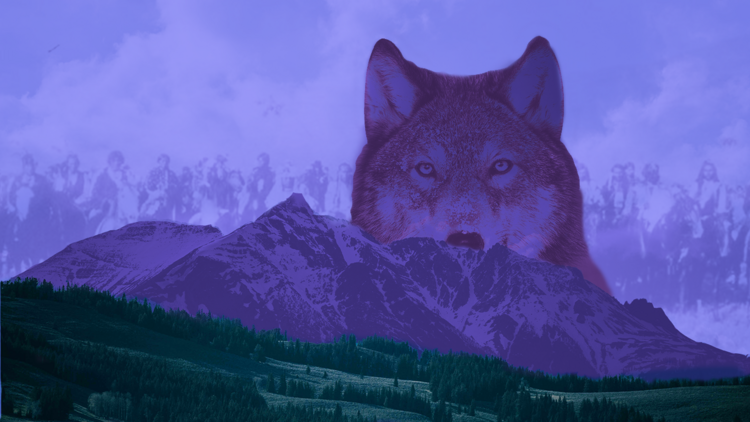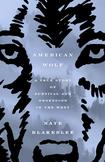Humans and wolves: Are we more alike than we think?
Something about wolves has always captivated the human imagination. They often haunt the dark forests of our minds, from childhood tales of the Big Bad Wolf to race-baiting headlines comparing humans to these canine hunters, as when the Central Park 5 were deemed a “wolfpack.” The negative association is perhaps a vestige of a time when our ancestors knew the wolf not just as a predator of our herds and flocks, but as one of the few animals that could hunt us.
American Wolf, by Nate Blakeslee, tells the tale of the latest manifestation of this primordial clash between humans and wolves. Set against the epic backdrop of Yellowstone National Park, American Wolf reads like a Western. This is a generational epic of violent survival in a rugged and harsh land. And for anyone intrigued by canis lupus, there is more to this story than just the tale of human versus wolf; it is also the tale of wolf versus wolf and human versus human. As one delves deeper and deeper into the text, one begins to sense that perhaps the two species are not as different as we might think.
The action revolves around the reintroduction of the wolf to Yellowstone in 1995. The policy was born of good environmental stewardship; elk overpopulation had proven devastating to the local ecosystem since the wolf was eliminated in the 1920s. Nevertheless, the introduction of a deadly predator to their region understandably provoked significant resistance from the locals, some of whom saw it as an example of government overreach. Why was Washington, D.C., forcing literal wolves on communities? Blakeslee makes sure the reader can sympathize with the local hunters and ranchers whose livelihoods are threatened by wolf reintroduction. A domestic animal lost to predation represents a significant loss of resources. A elk eaten by wolves is one fewer that could be hunted by a family to supplement a limited grocery budget. Should someone really go to jail under the Endangered Species Act for shooting a wolf? It is a familiar fault line: To what extent can the government be allowed to affect the lives of people living far away from the Beltway?
But the wolf characters prove just as compelling as the humans. Backed by over two decades of notes and observations from scientists, park rangers and amateur wolf enthusiasts, Blakeslee chronicles the intriguing, violent and primal lives of the wolf protagonists. Dynasties rise and fall, wars over territory and mates are bitterly waged; a pack overthrows its cruel alpha female, with her kinder sister taking her place. Duels to the death are carried out. And amidst it all individual wolves are recorded as showing empathy, even heroism. Like the humans who watch them, readers also come to care for these wolves, not just as a species but as individuals. The inevitable violence between human communities and wolves becomes all the more tragic.
When one reads of the wolf packs battling for territory, forming borders and attacking outsiders, one sees something not unlike how human tribes fought over the West, formed borders and attacked outsiders.
American Wolf can boast the attributes of any good story: interesting characters brought into clear conflict. However, the deeper themes of the book can be found in considering the implications of the book’s setting. This is the land scarred by the wars of American colonization. The town the ranchers and hunters live in and the creek that runs through the valley the wolves claim as their own are both named Crandall, after a white prospector beheaded by Native American Indians. The older men can remember their own grandfathers’ stories of fighting the Nez Perce for the land. The connection between colonial violence and environmental stewardship may not seem obvious on the surface. But it was only after “the winning” of the West that Yellowstone’s ecosystem and wolf population was first decimated. Today, it is indigenous people who continue to be at the forefront of fighting to protect the environment.
This is the great strength of American Wolf. Blakeslee sees beyond the straightforward tale of the conservation of an endangered species and uncovers a West not quite “won.” Mastery of the American continent is still being contested, between species and among them. This is what validates the book’s claim to being a Western, that most American of genres. When one reads of the wolf packs battling for territory, forming borders and attacking outsiders, one sees something not unlike how human tribes fought over the West, formed borders and attacked outsiders. Is not the U.S.-Mexico border that frontier today? Thinking of atrocities like the Wounded Knee massacre or Mexican Repatriation, I find that our own history reflects the worst and most animalistic traits of the wolf.
What was it like in that first moment, lost to ancient pre-history, when a wolf and a human first made an alliance? Our species are so alike, for good and for ill.
At the same time, humans reflect many of the lupine qualities that conservationists fall in love with. It is no wonder that despite obvious enmity, some wolves did become friends to man. Those wolves are the ancestors to today’s dogs. “Humanity’s most beloved animal and its most despised were essentially the same creature,” Blakeslee observes. There is a duality in humanity’s relationship with wolves. We see them as full of potential —for danger but also perhaps for alliance.
The people of Yellowstone’s polarized reactions to wolf reintroduction echo thousands of years of this love-hate relationship. It makes me wonder: What was it like in that first moment, lost to ancient pre-history, when a wolf and a human first made an alliance? Our species are so alike, for good and for ill. Perhaps this is why, despite millennia of taming wolves and bringing them into our homes, our cultural view of them remains a negative one. Perhaps our fear of wolves is, deep down, a reflection of our fear of each other and of ourselves.
This article also appeared in print, under the headline “Our canine kin ,” in the March 19, 2018, issue.











